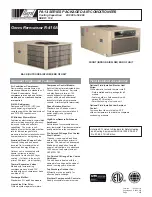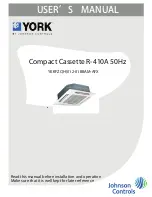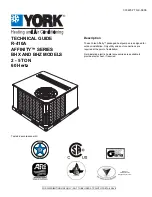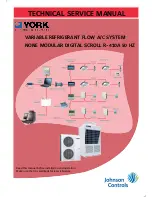
45˚± 2˚
A
B
ø
A
A
B
C
D
6
4. Installing the refrigerant piping
4.1. Precautions for devices that use R410A refrigerant
• Refer to 1.5. for precautions not included below on using air conditioners
with R410A refrigerant.
• Use ester oil, ether oil, alkylbenzene oil (small amount) as the refrigeration
oil applied to the flared sections.
• Use C1220 copper phosphorus, for copper and copper alloy seamless
pipes, to connect the refrigerant pipes. Use refrigerant pipes with the thick-
nesses specified in the table to the below. Make sure the insides of the
pipes are clean and do not contain any harmful contaminants such as sul-
furic compounds, oxidants, debris, or dust.
Warning:
When installing or relocating, or servicing the air conditioner, use only the
specified refrigerant (R410A) to charge the refrigerant lines. Do not mix it with
any other refrigerant and do not allow air to remain in the lines.
If air is mixed with the refrigerant, then it can be the cause of abnormal high
pressure in the refrigerant line, and may result in an explosion and other haz
-
ards.
The use of any refrigerant other than that specified for the system will cause
mechanical failure or system malfunction or unit breakdown. In the worst
case, this could lead to a serious impediment to securing product safety.
Liquid pipe
ø9.52 mm, 3/8inch
thickness 0.8 mm, 1/32 inch
Gas pipe
ø15.88 mm, 5/8 inch
thickness 1.0 mm, 3/64 inch
• Do not use pipes thinner than those specified above.
4.2. Connecting pipes (Fig. 4-1, Fig. 4-2)
When commercially available copper pipes are used, insulate both the liquid
and gas pipes separately with commercially available insulation materials (heat-
resistant to 100°C, 212°F or more, thickness of 12 mm, 1/2 inch or more).
(Fig. 4-1)
• The indoor parts of the drain pipe should be wrapped with polyethylene foam
insulation materials (specific gravity of 0.03, thickness of 9 mm, 23/64 inch or
more).
[Fig. 4-2]
• Apply thin layer of refrigerant oil to pipe and joint seating surface before tighten-
ing flare nut.
A
• Use two wrenches to tighten piping connections.
B
• Use leak detector or soapy water to check for gas leaks after connections are
completed.
• Apply refrigerating machine oil over the entire flare seat surface.
C
• Use the flare nuts for the following pipe size.
D
Gas side
Pipe size (mm, inch)
ø15.88, 5/8”
Liquid side
Pipe size (mm, inch)
ø9.52, 3/8”
*: The flare nut is supplied as an outdoor unit accessory.
Be sure to use it otherwise gas leakage or even pipe extraction may occur.
• When bending the pipes, be careful not to break them. Bend radii of 100 mm,
3-15/16 inch to 150 mm, 5-27/32 inch are sufficient.
• Make sure the pipes do not contact the compressor. Abnormal noise or vibration
may result.
1
Pipes must be connected starting from the indoor unit.
Flare nuts must be tightened with a torque wrench.
2
Flare the liquid pipes and gas pipes and apply a thin layer of refrigeration oil
(Applied on site).
Warning:
When installing the unit, securely connect the refrigerant pipes before start-
ing the compressor
.
A
(Fig. 4-1)
Copper pipe O.D.
Flare dimensions
øA dimensions
(mm)
(inch)
(mm)
(inch)
ø6.35
1/4”
8.7 - 9.1
11/32 - 23/64
ø9.52
3/8”
12.8 - 13.2
1/2 - 33/64
ø12.7
1/2”
16.2 - 16.6 41/64 - 21/32
ø15.88
5/8”
19.3 - 19.7 49/64 - 25/32
B
(Fig. 4-1)
Copper pipe O.D.
Flare nut O.D.
Tightening torque
(mm)
(inch)
(mm)
(inch)
(N·m)
(ft·lbs)
ø6.35
1/4”
17
43/64
14 - 18
10 - 13
ø9.52
3/8”
22
7/8
34 - 42
25 - 30
ø12.7
1/2”
26
1 - 3/64
49 - 61
35 - 44
ø15.88
5/8”
29
1 - 9/64
68 - 82
49 - 59
A
Liquid pipe
B
Gas pipe
C
Insulation
D
Taping
A
Flare cutting dimensions
B
Flare nut tightening torque
Fig. 4-1
mm (inch)
Fig. 4-2
C
D
R0.4 (1/64) to
R0.8 (1/32)
90˚± 0.5˚
en
BH79D886H09_01en.indd 6
2021/12/24 16:56:42
007
Содержание PUZ-HA24NHA1
Страница 35: ...A4_white_tombo indd 1 2018 08 09 14 11 29 035 ...








































